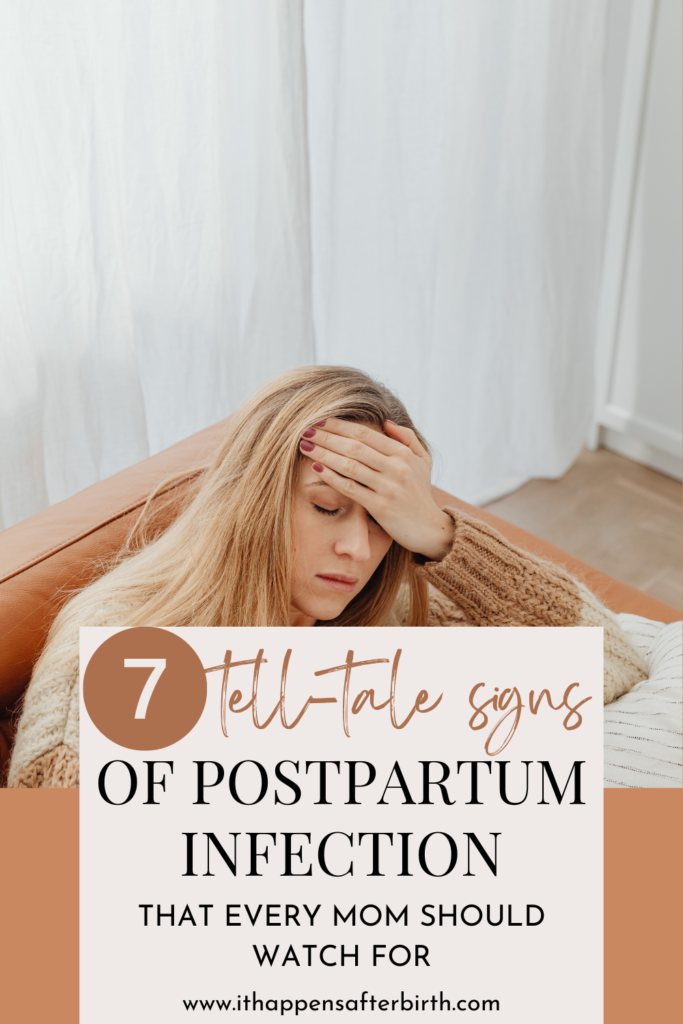It’s easy to identify common signs that tell you if you might have a postpartum infection. We’ll go through them in the post.

There’s a lot to occupy your mind after giving birth: health of your baby, feeding, mental health, etc.
Often, though, your immediate attention is focused on your physical recovery. After all, that’s what your feeling most in your body.
Most of the time we just want to feel better as quickly as possible- but unfortunately, postpartum infection is a very real possibility in the first week or two after birth.
While it may not seem like a big deal, there are severe risks to postpartum infection, including sepsis and death. It is rare, but something that all new parents should monitor carefully. If you recognize any of these signs in yourself, please contact your care provider as soon as you can.
Common Risk Factors for Postpartum Infection
While these scenarios don’t in any way guarantee you’ll end up with an infection, they do raise the risk of developing one. It could be worth keeping a closer eye on symptoms if you experienced any of these.
- Water breaking before labor started (officially known as PROM, or Premature Rupture of Membranes).
- Vaginal examinations during labor- the more examinations you had, the higher the chance of infection.
- Cesarean section (whether planned or unplanned, but the risk of infection is slightly higher with an unplanned c-section).
- Retained placenta.
- Any manual placental extraction.
- Internal fetal monitoring during labor.
- Excessive bleeding or hemorrhaging after birth.
Studies show that somewhere between 5-7% of women will develop an infection after birth. The most recognizable is infection of the uterus (otherwise known as puerperal infection in medical speak), but UTIs and mastitis are also a possibility. You can also get an infection around the perineum, vagina, and c-section incision.
Check out this post for tips on aiding c-section recovery.
So what are the signs of infection?
Thankfully, the signs of infection are straightforward and simple to look for.
Keep an eye out for:
- Fever of 100.4 F or higher
- Excessive bleeding (more than 1 pad per hour) or large clots (bigger than a golf ball)
- Redness, warmth, and pain around tears/stitches
- Foul smelling discharge, or foul smell around stitches.
- Chills
- Abdominal pain (different from after-birth contractions)
- Vision changes
If you’ve had a c-section, also look for:
- Separation of the scar
- Redness, warmth, or tenderness around your incision
- Foul smell coming from your incision
Experiencing just one of these can mean that an infection is developing, and if it is, it needs to be treated. Get in touch with your provider and ask about treatment options.
What’s the big deal about an infection?
A lot, actually. An infection is one of the highest causes of maternal death after birth, and the fact that they can crop up quickly with only one or two symptoms makes it even more important to be on guard.
Risks of postpartum infection include blood clots, abdominal inflammation, sepsis- and death.
Signs of sepsis (what an infection can become if left untreated) include:
- Disorientation
- Fast heart rate
- Clammy skin
- Chills/shaking
- Rapid breathing
- Extreme pain
If you start noticing any of these signs or symptoms, even if you didn’t feel sick before, TAKE IT SERIOUSLY. Check in with your provider immediately, go to the hospital, or if it seems very serious, consider calling an ambulance.
Caution can be a good thing
Many other countries have made huge strides when it comes to taking care of women after childbirth. In the United States, however, most women don’t see a doctor/care provider until 4-6 weeks after birth- leaving them susceptible to infections and complications. They don’t have anyone to guide them through this crucial time.
I would love to see this change one day, but in the meantime, we need to make sure we’re looking after ourselves. If you have a partner or someone else close you can trust, enlist them to help keep an eye on you. When we give birth, it’s easy to let our focus shift to our newborn. But don’t forget that your health and well-being are incredibly important also!
So even if you feel like you’re being paranoid- always remember that it’s better to be safe than sorry. It might seem ridiculous to contact your provider because you’re running a slight fever, but that fever could just as easily turn into something more. Monitor it! And don’t ever feel silly for making sure.

